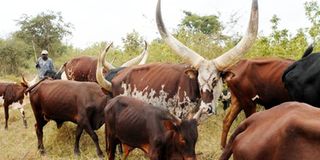Farmers raise alarm over foot and mouth disease

Cattle graze at a farm recently. File photo
Representatives of stakeholders in the beef, piggery and poultry have expressed concerns about the seemingly unchecked outbreaks of the foot and mouth disease (FMD) in Uganda and what they have called sluggish approach by government in finding a solution.
Coming together under AgriProFocus Nyama Platform, which comprises farmers, private companies, NGOs, researchers, scientists and other players in the meat industry, they are requesting urgent intervention from policy makers. They intend to raise awareness of the extent of the disease, cause discussions in the highest levels of government and thus push for action.
In a meeting with the parliamentary committee on agriculture, on February 25, the Nyama Platform presented a statement in which they outlined the socio-economic effects of the FMD outbreaks. This includes loss of livestock products such as meat, milk and other dairy products, and death in especially pregnant females and young animals.
“It is our prayers that this Committee gives this issue utmost attention,” said Robert Serwanga, one of the members. “To raise it with the persons concerned and put them to task about what they are doing about controlling outbreaks of foot and mouth disease.”
The Nyama Platform representatives also expressed their disappointment over the nature of the response when incidences of the disease are reported. Usually a quarantine is placed over the area to restrict movement of animals and vaccines administered. However, the time taken between reports, placing of a quarantine and procurement of medicines is too long which reduces the effectiveness of the measures.
They also pointed that often the quarantines are flouted by unscrupulous individuals with the protection of district authorities in some cases. This allows the animals to move and contributes to the spread of the disease to different areas, which were previously unaffected. Also, when the vaccines are available, the number is inadequate.
In providing statistics to illustrate their point, they cited the case of Nakaseke District. An outbreak of FMD was reported in November 2014. It has been traced to a cow that was transported from Kalerwe market in Kampala back to Nakaseke. And only 3,000 doses of vaccine were sent there yet there are more 160,000 heads of cattle in the districts. The economic loss is expected to amount to Shs21b.
“FMD does not necessarily kill an animal. It affects productivity, with this a farmer losses every day,” said Dr Nsegiyunva, Nyama Platform member while explaining FMD to the parliamentarians. “When you look at the economics of destroying a herd compared to getting vaccines to a whole district, it is better to destroy the herd and compensate the farmer.”
In his response, the Agriculture Committee chairperson, Matthias Kasamba suggested that the concerns raised are fashioned into a motion that is raised for debate in Parliament. He advised the Nyama Platform to beef up the statement with case studies and more figures to make a stronger case to the policy makers.
Counting the costs
• Compromise food security through serious loss of animal protein and/or loss of draught animal power for cropping.
• Cause major production losses for livestock products such as meat, milk and other dairy products.
• Cause losses of valuable livestock of high genetic potential. Exotic high-producing breeds are extremely susceptible to FMD.
• Increased cost of livestock production since costly disease control measures need to be applied.
• Seriously disrupt or inhibit trade in livestock, and livestock products, within and outside the country.
• Outbreak and spread of FMD causes substantial losses, in particular amongst young livestock, where mortality is high and pregnant females, where the disease causes abortions, It also has a long-lasting effect on yield curves (meat and milk), as animals which recover do not always regain their previous potential
The situation
Among the factors that hinder the availability of safe meat to the population are several outbreaks of foot and mouth disease (FMD) in Uganda.
The first outbreak was recorded in 1953. Since then, they occur annually and do not seem to follow a particular pattern but rather occur sporadically at any location at any time of the year. They have become more frequent and have increased over time.
FMD is an extremely contagious viral disease which affects both domestic (cattle, sheep and pigs) and wild animals (buffaloes).
It respects no borders and is listed among “Class A notifiable livestock diseases” that need urgent attention including taking extreme control measures like strict control of animal movement and routine vaccination campaigns. However, the recommended control measures in Uganda are lacking. For this reason, the outbreaks are frequent and are on the rise.
Rising outbreaks
This is evidenced by a series of outbreaks over the years. For example, from 1996 to 1999, over 15 outbreaks were recorded per year. From 2000 to 2007, 23-28 outbreaks occurred annually. And, in the period January 2013 to December 2014, 41 FMD outbreaks were recorded in 33 districts.
In essence, this means that every month, on average, there were two outbreaks anywhere in the country, this pattern underscores the any control measures being undertaken.
In principle, it is the responsibility of the government under Animal Disease Act 1964 to control notifiable animal diseases. Presently, veterinary services are not in position to implement comprehensive vaccination programmes for FMD in Uganda.
Responses to the outbreaks is in a “fire brigade” manner and vaccinations are done only in infected areas. Even then, the procurement process for the vaccine is time-consuming. In Uganda, FMD is endemic and there are seven distinct types of the virus. Out of these, all except one have been recorded in the country.




